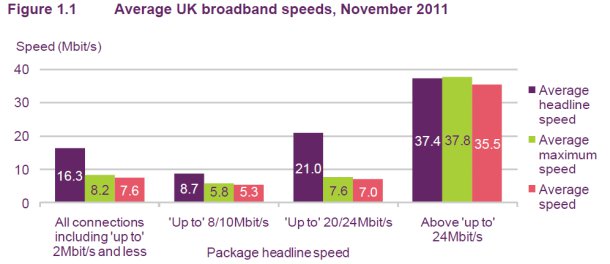UK broadband speed climbs 22 percent

Telecoms watchdog Ofcom has said that the average broadband speed in the UK increased by nearly 22 percent in the year up to November 2011.
The average actual speed received has increased to 7.6Mbps from 6.2Mbps last year, Ofcom said in its UK fixed-line broadband report published on Thursday. The report covers the six-month period between May and November 2011 and only measures residential broadband speeds.

Advertised speeds compared with what was delivered, across a range of levels. Image credit: Ofcom
Despite the overall increase, the report noted a decline in speeds for people on copper-based packages advertised at 'up to' 24Mbps and above 24Mbps, from 7.4Mbps to 7.0Mbps and from 38.2Mbps to 35.5Mbps, respectively.
Ofcom attributed these declines to "the migration of BT and Virgin Media customers onto higher-speed services". It said BT's expansion into rural areas with its ADSL2+ technology has resulted in more people with longer distances between their houses and their exchange. This then results in lower download speeds, contributing to the overall decline in speeds advertised at 'up to' 24Mbps.
In addition, the organisation noted that with fibre services, headline speeds — the 'up to' speed advertised for each package — are far closer to real average speeds. This applies primarily to fibre-to-the-cabinet (FTTC) connections, rather than copper-based connections.
Most fibre connections in the UK are currently fibre-to-the-cabinet (FTTC), meaning that the last stretch between the cabinet and premises is still run over copper cables. However, fibre-to-the-premises (FTTP), which offers far higher maximum speeds than copper, is now being rolled out in some areas of the UK.
During the six-month period, people on 'up to' 20/24Mbps connections achieved just 31 percent of the headline speed. By comparison, fibre-based packages reached between 90 and 103 percent of their advertised headline speeds.
In September, the advertising code-writing bodies — CAP and BCAP — reviewed the rules on broadband advertising speed claims. As a result, new guidance set to come into force in April will require at least 10 percent of an ISP's customers to achieve the advertised headline speed for the advertisements to be deemed not misleading.
Rural gap
However, the bigger issue is the growing speed divide between the quality of broadband provided in town and country, according Ernest Doku, technology expert at uSwitch.com.
"It will come as no surprise to many of us that there's often a discrepancy between the super-fast speeds advertised by broadband providers and the actual speeds that we get at home," Doku said in a statement. "But there's another elephant in the room that this data doesn't mention: the gaping divide between speeds in urban and rural areas."
The gap between downloads in rural areas and in town affects both maximum and average speeds. Image credit: Ofcom
In the past, operators have been reluctant to bear the cost of installing the infrastructure needed to provide faster services to rural areas. This is because because rural areas tend to have low population density, making them a worse return on investment.
The government has committed more than half-a-billion pounds to improving the speeds of fixed-line broadband in Scotland, England and Wales through its Broadband Delivery UK (BDUK) scheme. It aims to deliver super-fast broadband to the majority of the UK before 2015, and an absolute minimum of 2Mbps to everyone.
Matt Hawkins, managing director at C4L, believes the rural conundrum could be solved through a mix of technologies, and not just by improving fixed-line services.
"When it comes to rural broadband, the trouble is that it's just not profitable enough for most large providers to expand from their established customer base in urban areas to more remote communities. As a result, it's down to local government and initiatives such as the Rural Community Broadband Fund to reach out to the roughly 25 percent of the country who aren't currently covered," Hawkins said in a statement.
"In order to do this, they need to explore all available technologies for connecting communities, whether fibre connections, wireless transmission or even satellite broadband. Most importantly, any connection needs to be both fast and reliable: there's no point in connecting remote areas if that connection can be just as easily severed," he added.
Get the latest technology news and analysis, blogs and reviews delivered directly to your inbox with ZDNet UK's newsletters.